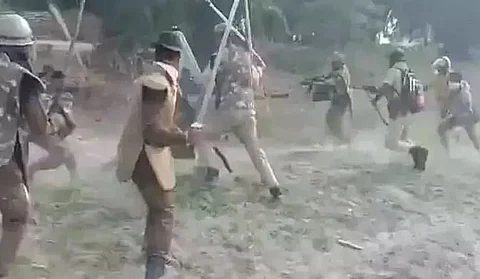
- Home
- Live Blog
- Breaking News
- Top Headlines
- Cities
- NE News
- Sentinel Media
- Sports
- Education
- Jobs

The incident which occurred at Gorukhuti near Sipajhar in the Darrang district on Thursday is a serious matter. But then, it is nothing new as far as the larger design and conspiracy of converting Assam into a Pakistan – or a Muslim-majority state – is concerned. There is a whole gang of self-appointed intellectuals, human rights activists and some journalists too, who continue to accuse the Assamese and other indigenous communities of repeatedly targeting 'Muslims' in the name of protecting identity. Congress and Communist politicians also belong to the same category. They however refuse to see that Assam has been witnessing an invasion by hordes of land-hungry Muslims from erstwhile East Bengal, erstwhile East Pakistan and present-day Bangladesh since Lord Curzon had clubbed Assam with Eastern Bengal to create a new province in 1905. Though that decision was revoked in 1911, the floodgates have remained open for more than a century now. The demography of Assam has been dangerously altered, the environment – forests, wildlife sanctuaries, National Parks, PGRs, VGRs, government land, land belonging to Assamese monasteries and other religious institutions – have been seriously affected, in many districts, the indigenous communities have been reduced to a minority, crime patterns have changed, abduction and conversion of girls of indigenous communities have become a routine problem, not a single Hindu temple has been spared by thieves and burglars, democratic politics has been changed – all because of the large-scale influx of land-hungry Muslims from the neighbouring country. One does not have to go very far to understand this problem. S C Mullan, ICS, then Census Superintendent of Assam, wrote exactly 90 years ago, in 1931, "Probably the most important event in the province during the last twenty-five years - an event, moreover, which seems lively to alter permanently the whole future of Assam and to destroy more surely than did the Burmese invaders of 1829, the whole structure of Assamese culture and civilization - has been the invasion of a vast horde of land-hungry Bengali immigrants; mostly Muslims, from the districts of Eastern Bengal sometime before 1911 and the census report of that is the first report which makes mention of the advancing host. But, as we now know, the Bengali, immigrants censused for the first time on their sar islands of Goalpara in 1921 were merely the advance guard - or rather the scouts - of a huge army following closely at their heels. By 1921 the first army corps had passed into Assam and had practically conquered the district of Goalpara. Where there is wasteland thither flock the Mymensinghias. How they have seized upon the vacant areas in the Assam valley seems almost uncanny. Without fuss, without tumult, without undue trouble to the district revenue staff, a population which must amount to over half a million has transplanted itself from Bengal into the Assam Valley during the last twenty-five years. It looks like a marvel of the administrative organization on the part of the Government but it is nothing of the sort; the only thing I can compare it to is the mass movement of a large body of ants… it is sad but by no means improbable that in another thirty years the Sibsagar district will be the only part of Assam in which an Assamese will find himself at home." Mullan was neither an Assamese chauvinist nor a political activist or instigator. The dream of Jinnah and his Muslim League to include Assam in Pakistan is still being pursued. As former Assam Governor Lt Gen (Retd) SK Sinha had stated in his report to the President in November 1998, said, failure to get Assam included in East Pakistan in 1947 remains a source of abiding resentment in that country. He had also quoted ZA Bhutto, who in his book, Myths of Independence wrote, "It would be wrong to think that Kashmir is the only dispute that divides India and Pakistan, though undoubtedly the most significant. One at least is nearly as important as the Kashmir dispute, that of Assam and some districts of India adjacent to East Pakistan. To these Pakistan has very good claims." The Supreme Court of India had extensively analysed the dangers posed by immigrants to Assam and had more than once described it as a "silent invasion" and "external aggression" of Assam. Chief Minister Himanta Biswa Sarma on Friday recalled how eight Assamese youth were lynched to death by immigrant Muslim encroachers in 1983 in the same area where eviction has been launched. What was seen at Gorukhuti on Thursday was nothing but only a small glimpse of the growing clout of the infiltrators/encroachers. The land is their prime target. While the BJP-led alliance has vowed to protect "jaati-maati-bheti" of the indigenous people, the infiltrators are out to wipe out the same "jaati-maati-bheti" of the indigenous communities.